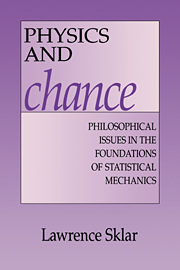Book contents
- Frontmatter
- Contents
- Preface
- 1 Introduction
- 2 Historical sketch
- 3 Probability
- 4 Statistical explanation
- 5 Equilibrium theory
- 6 Describing non-equilibrium
- 7 Rationalizing non-equilibrium theory
- 8 Cosmology and irreversibility
- 9 The reduction of thermodynamics to statistical mechanics
- 10 The direction of time
- 11 The current state of major questions
- References
- Index
- Frontmatter
- Contents
- Preface
- 1 Introduction
- 2 Historical sketch
- 3 Probability
- 4 Statistical explanation
- 5 Equilibrium theory
- 6 Describing non-equilibrium
- 7 Rationalizing non-equilibrium theory
- 8 Cosmology and irreversibility
- 9 The reduction of thermodynamics to statistical mechanics
- 10 The direction of time
- 11 The current state of major questions
- References
- Index
Summary
Philosophy and the foundations of physics
There are four fundamental theories that constitute, at present, the foundational pillars of our physical theory of the world: general relativity, quantum mechanics, the theory of elementary particles, and statistical mechanics. Physics is of course far from a finished discipline, and each of these fundamental theories presents its own budget of scientific and philosophical problems. But the kinds of problems faced by those who would examine the so-called foundational issues in these areas vary in a marked and interesting way from theory to theory.
General relativity — at present the most plausible theory of the structure of space-time, a domain of inquiry that, since Einstein, is usually taken to include the theory of gravitation — is in many ways the most fully worked out of the theories. Many fascinating scientific questions remain: Should we accept general relativity, or some alternative to it like the Dicke—Brans scalar-tensor theory? Are there generalizations of the theory that might encompass other forms of interaction over and above gravitation? Should the allowable worlds be restricted by some conditions of causal “niceness,” for example? But we are, at least, clear about what the theory itself amounts to. Scientifically, the most dubious aspect of the theory is its totally classical nature, and all expect that some day we will have a new quantized theory to take its place.
- Type
- Chapter
- Information
- Physics and ChancePhilosophical Issues in the Foundations of Statistical Mechanics, pp. 1 - 13Publisher: Cambridge University PressPrint publication year: 1993



